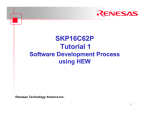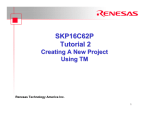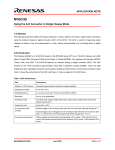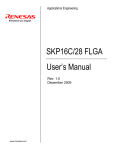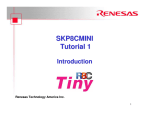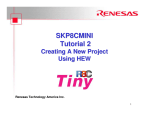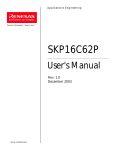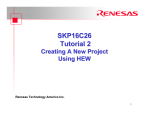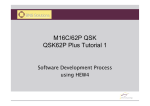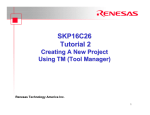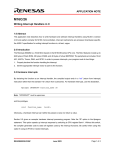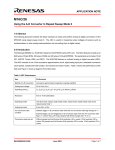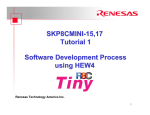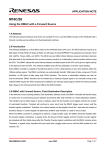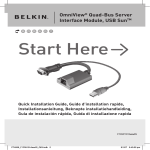Download Software Development Process Software Development Process
Transcript
SKP16C62P Tutorial 1 Software Development Process Using TM (Tool Manager) Renesas Technology America Inc. 1 Overview The following tutorial is a brief introduction on how to develop and debug programs using the software and hardware tools included with the SKP16C62P. To get the most out of the Starter Kit, check out the references at the end of this tutorial. Note: The tutorial assumes the user has followed the ‘Quick Start Guide’ and all the software tools and examples have been installed in the default directories. 2 The Development Process M16C/62P MCU RAM 5. Correct errors & repeat process Flash User RAM Monitor RAM I/O Connector 1. Write programs using text editor User Flash Monitor Flash 2. Tool Manager automates compile & link SIO UART1 ICD SKP16C62P Board Host PC Editor Editor (eg. Notepad) (eg. Notepad) Correct Errors Project files Tool Manager Project Bar Project Bar and Project and Project Editor Editor 3. KD30 sends the machine code to the SKP16C62P during downloads and uses the symbols for source level debugging .c .h .a30 .inc Build command USB 4. Debugging info sent back & forth Builder: Error reporting Builder: Error reporting NC30 Compiler NC30 Compiler AS30 Assembler AS30 Assembler Options and Settings 3 .r30 files Machine Machine Code Code LN30 Linker LN30 Linker Absolute Absolute file file “.x30” “.x30” KD30 Debugger Debug Debug Symbols Symbols SKP16C62P Connectivity 4 SKP16C62P Board Expansion Port Power LED Reset SW 8-character x 2-line LCD Thermistor Analog Adjust Pot LCD Contrast JP2 Xout JP1 MCU Power 12MHz Crystal M16C/62P M30626FHPGP User LED's FoUSB-ICD Connector 32KHz Crystal Expansion Port User Pushbutton Switches 5 J1 SKP16C62P Board Features M16C/62P(M30626FHPGP) MCU • • • • • • • • • 24MHz Operating Frequency at 3.0V – 5V 384kB Flash ROM, 4kB Virtual EEPROM, and 31kB RAM 87 GPIO and 4 Key-on Wakeup Inputs 11 Timers plus a Watchdog Timer 26-channel 10-bit ADC 2-channel 8-bit DAC 2 DMAC 5 SIO’s (supports I2C and SPI) CRC Circuit Onboard User Controls • • • • • LED’s (3 User, 1 Power) Removable 2-line x 8-character LCD Pushbutton Switches (3 User, 1 Reset) Thermistor and potentiometer tied to an A/D input I/O available on Expansion Ports 6 ICD (RTA-FoUSB-MON) The ICD (In-Circuit Debugger) provides a USB interface to the Host PC and communicates commands and data to and from the SKP16C62P board via a synchronous serial interface. As a debugging tool (during program debug), the ICD + KD30 downloads a small kernel (or ROM Monitor) program with the user program to the SKP16C62P Board . This kernel provides a communication interface between the M16C/62P MCU and the ICD + KD30 Debugger application on MCU status. While the kernel uses some resources of the M16C/62P, the operation of the ICD is transparent to the user’s program. As a programming tool, the ICD + Flash-over-USBTM(FoUSB) Programmer can be used to download user programs to the M16C/62P MCU on the SKP16C62P Board and other Renesas’ M16C Flash MCU’s (the ICD will support other M16C MCU’s by downloading a MCU Monitor Image (MMI) file for a particular MCU thru KD30 or FoUSB Programmer). NOTE: The kernel is only downloaded with the user program when using KD30 Debugger but NOT the FoUSB Programmer. 7 Development Tools Tool Manager An Integrated Development Environment (IDE) that invokes all necessary software for building your project KD30 PC software that communicates with the ROM Monitor Program (in flash on the MCU) for program debug KNC30 C-compiler (limited version of NC30). Conforms to ANSI C standards AS30 Relocatable Assembler Supports structured language and wide variety of macro instructions Flash-over-USB Programmer Flash programmer for Renesas M16C Flash MCU’s. 8 Tool Manager Overview When writing a microcontroller (or any computer) program, the program is usually split into multiple files to make it easier to read and understand. While exactly how the files are organized is up to the programmer, typically, the code is split up in a logical manner into various files (e.g. math functions in one file, serial port drivers in another, etc). After all the files in a project are compiled and assembled, a linker combines all the files into a single file. These steps can be tedious and repetitive. To make the process simple, we use an Integrated Development Environment (IDE) called “Tool Manager (TM)”. 9 Start Tool Manager (TM) From the Windows Start menu, click on Programs > Renesas-tools > TM V3.X > TM 10 Tool Manager Project Bar Open project button Rebuild button Start new project wizard Build button Partial build button Project currently loaded Run debugger button Help button Tool register button Open project editor button Map Viewer button Start default editor button Tool Manager customize button 11 Tool Manager Exercise We will now perform the following steps: • Open an existing project • Build (re-build) an existing project 12 Open an Existing Project: Step 1 To open an existing project, click on this icon. 13 Open an Existing Project: Step 2 Locate the C:\MTOOL\SKP16C62P\sample_code directory and open the “tutor1” folder. 14 Open an Existing Project: Step 3 Select “tutor1.tmk” 15 Open the Project Editor Click on ‘Project Editor’ icon. 16 Project Editor Command window Editor window Normally, you will only be concerned with the editor window. Now click on the ‘+’ by ‘all’, then click on the ‘+’ by ‘tutor1.x30’, then the ‘+’ by ‘tutor.r30’. 17 Editor Window This illustrates that the object file ‘main_tutor1.r30’ depends on these source files. Double-click on ‘main_tutor1.c’ to open it in the default editor, ’Notepad’. Tool Manager can also be set up to use your favorite editor. To change the default editor, click on the ‘Tool Register’ icon on the ‘Tool Bar’. 18 Build(re-build) an Existing Project Build Re-build Build the project into an executable module by clicking on the ‘Rebuild’ icon. This will re-compile and link all the source files. Clicking the ‘Build’ icon will only compile files that have been modified since the last build. Always ‘Rebuild’ when any compiler or Tool Manager options have changed. Clicking on any of the build icons opens the ‘Builder’ window... 19 Builder Window The major use of the window is to determine if any errors, or warnings, occurred and where. The no. of errors and warnings will show up in this window. You can then scroll up to find where the error(s) occurred. If no errors were found, ‘… Finish…’ will be displayed. Now that you have finished compiling/linking the file, the next step is to download and run the program on the SKP16C62P Board using the KD30 Debugger and ICD… Do not close Tool Manager yet. We will be returning to it later. 20 KD30 Debugger Overview The KD30 Debugger can be used to verify that the program we developed works exactly as we intended and when it does not, we can use KD30 to find out why. Breakpoints can be set in KD30 to stop the program at certain points (of our program) so we can verify that up to that point, the program still works correctly using registers or variables in memory. The number of breakpoints will vary from MCU to MCU. For the M16C/62P, the maximum no. of breakpoints for KD30 is 8. KD30 also allows “step” execution in our program, which means program execution on a per line basis (whether in source level or machine code level). Various windows in KD30 allow us to see register values and memory locations. 21 KD30 Debugger Exercise • Download and run a program on the SKP16C62P board • General use of the KD30 Debugger including stepping and setting breakpoints • Return to Tool Manager, modify the program, rebuild, and run the updated program on the SKP16C62P board 22 Connect Hardware Before starting KD30, connect the ICD to the SKP16C62P Board as shown. Connect the USB cable to the PC. On the ICD, the Power LED is on and the Status (Yellow) LED is blinking once a second (this means that the ICD USB driver was loaded correctly by WindowsTM). 23 Start KD30 Launch KD30 from the Windows Start Menu, or from ‘Tool Manager’. 24 KD30 Init Window Step 3. Now click the ‘Run Mode’ tab Step 1. Click on ‘Refer..’ and select ‘M30626FHP.mcu’. Step 2. Select USB 25 KD30 Init Window For full debugging features, be sure ‘Sampling Mode1’ is selected. ‘Free Run Mode1’ is for real time execution of your program, but debugging is limited. Do not select for this tutorial. Now click ‘OK’ to open KD30’s Program window (be sure hardware is connected). If you get an error, check all connections. See SKP user’s manual on ‘Troubleshooting’ for details. Note 1. See KD30 Help for the differences between Sampling Mode and Free Run Mode. Also, see the ICD User’s Manual for details on how ICD works under these two modes. 26 KD30 Program Window KD30 will disassemble the flash contents or display ‘UND’ if the flash is blank. 27 KD30 Toolbar Go Button Step Button Break Button Executes target program One step execution of target program Sets a software breakpoint at the current cursor position Return Button Runs the program up to the higher routine Come Button Executes the target program from the value in the program counter to the position of the cursor in the window SW Button Sets a software breakpoint Stop Button Stops execution of the target program Reset Button Resets the target program Over Button Step over function/subroutine call 28 Download a Program to the SKP16C62P Board (M16C/62P MCU) Click on ‘File’, then select ‘Download’, ‘Load Module’. 29 Download a Program to the SKP16C62P Board (M16C/62P MCU) In the c:\MTOOL\SKP16C62P\sample_code \tutor1 directory, select ‘tutor1.x30’. 30 Download a Program to the SKP16C62P Board (M16C/62P MCU) After downloading the program, KD30 opens the file where the reset vector points to. Current location of MCU program counter is highlighted. Now click on “View” to see the program source code… 31 Viewing Source Files in the Project 1. Click ‘source’ 2. Source window is displayed. 4. Double-click ‘main’ to view it on the Program Window 3. Click ‘main_tutor1.c’ 32 Running Downloaded Program Click on the ‘Go’ icon to run the tutor1 program you just downloaded. LED’s D1, D2, & D3 will blink sequentially. Turning the Analog Adjust potentiometer on clockwise increases the LED blink rate and turning it counter-clockwise decreases the LED blink rate. Click ‘MIX’ to view the source code and assembler code. 33 Stopping Program Execution Click on the ‘Stop’ icon to stop the program 34 Setting Breakpoints 1. Click on the ‘Source’ to view source code only (not MIX display). 2. Locate and then set a breakpoint on ‘led_display();’ by a double-click on ‘-’ in the ‘BRK’ column that denotes an executable line. A ‘B’ will appear in its place after the breakpoint is set and the line is highlighted in red. 3. Click on ‘Go’ icon to run program… 35 Removing Breakpoints Program stops at breakpoint (highlighted in Yellow). You can remove the breakpoint by double-clicking on it at the ‘BRK’ column. 36 Program ‘Stepping’ Try ‘stepping’ a few lines of code by clicking on ‘Step’ icon. Click on ‘Go’ afterwards to run program again. 37 Basic Windows: Register Now open the ‘register’ window Values in red indicate changes since last “viewed”. Try ‘stepping’ and note the changes. The Register window displays the values of the CPU registers after executing an instruction. Note: Resize the ‘register’ window as needed. 38 Basic Windows: RAM Monitor Double-click an address and enter 400 (hex). KD30 will tell you the page is going to change, click ‘OK’ (adjust the window size as needed). The RAM Monitor displays the current value of the memory area shown on the window. It is updated at a preset value which can be modified by the user. Click the ‘GO’ icon. Note you can view the RAM as it is updating. This function is not available in “Free Run” mode. Click the ‘STOP’ icon before proceeding. 39 Basic Windows: Memory & C Watch The ‘C Watch Window’ allows you to view globals and locals. An example is shown below. Double-click on the variable to change display format: i.e., change ‘char’ to ‘hex’ to ‘decimal’, etc. The ‘Memory Window’ displays the location and contents of variables 40 Modifying the Program: Step 1 In the Project Editor, click on the ‘+’ by .\main_tutor1.r30. Double-click on .\main_tutor1.c to edit it. 41 Modifying the Program: Step 2 1. Scroll down and find the function ‘ta1_irq’ routine. 2. Change this line to ‘ta1 = (0x3FF – ad0);’. 3. Save the revised file (from the ‘File’ menu) 42 4. Build the project again. Load (re-load) Modified Program In KD30, with the program stopped, reload code by selecting ‘Reload’ from the File menu. Turning Analog Adjust potentiometer on SKP16C62P Board clockwise decreases the LED blink rate. Turning it counter-clockwise increases the blink rate. 43 End of Tutorial This is the end of the tutorial. You can try downloading other sample programs from the \Sample_Code directory. For a tutorial on creating a new project, check Tutorial 2 for details. In addition, check out the references on the next page. Have Fun!! 44 References and Recommended Reading All documents that came with the SKP can be found using the “Document Description” from the Start > Programs > Renesas-Tools > SKP16C62P menu. • • • • • • SKP16C62P User’s Manual: This is a “must read” document! It details all the things you need to know on how to use the Starter Kit. Tool Manager V3.X User’s Manual: To fully understand and get the most out of “Tool Manager”, this is recommended reading. KD30 Version X.XX User’s Manual: The tutorial only covered the basics of KD30. Read this manual to find out all of KD30’s features. NC30 Version X.XX User’s Manual: Check this manual out for features specific to the NC30 compiler. M16C/62P Datasheet and SKP16C62P Board Schematic: These are required to write user application programs for the SKP. RTA-FoUSB-MON User’s Manual: Read this manual to understand how the ICD works. 45 References and Recommended Reading • • • • M16C/10/20/60 Series C Language Programming Manual: This is a great document for any level of programmer. The first chapter is an intro to C programming. The next chapter explains the memory map of C programs on microcontrollers and the role of startup programs. M16C/10/20/60 Series Software Manual: This document describes the instruction set and timing information for the M16C/20/60 series CPU cores. AS30 Version X.XX User’s Manual: Read this manual if you plan on writing programs in Assembly or when making changes to the startup file. Application Notes and Sample Programs: Application notes and other sample programs can be accessed from Renesas Technology America’s website: http://www.renesas.com. 46














































